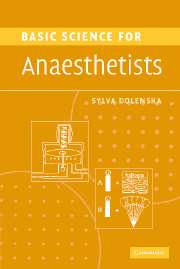Book contents
- Frontmatter
- Contents
- List of abbreviations and symbols
- List of figure captions
- Forewords
- Preface
- Preface to the second edition
- Part 1 Physics, mathematics, statistics, anaesthetic apparatus
- 1 Gas compression, relationship of volume, pressure and temperature
- 2 Real gas compression
- 3 Flow and resistance
- 4 Heat, vaporization and humidification
- 5 Simple mechanics 1: mass, force, pressure
- 6 Simple mechanics 2: work and power
- 7 Mathematical concepts
- 8 Exponentials 1: the curves
- 9 Exponentials 2: properties of exponential decay curve
- 10 Descriptive statistics
- 11 Presentation of data
- 12 Receiver operating characteristic curve
- 13 Gas supply and pressure
- 14 The circle system
- 15 The Mapleson A (Magill) breathing system
- 16 T-pieces
- 17 Lung filling with automatic lung ventilators
- Part 2 Clinical measurement
- Part 3a Physiology: the cardiovascular system
- Part 3b Physiology: the respiratory system
- Part 4 Pharmacology
- Further Reading
- Index
7 - Mathematical concepts
from Part 1 - Physics, mathematics, statistics, anaesthetic apparatus
Published online by Cambridge University Press: 13 August 2009
- Frontmatter
- Contents
- List of abbreviations and symbols
- List of figure captions
- Forewords
- Preface
- Preface to the second edition
- Part 1 Physics, mathematics, statistics, anaesthetic apparatus
- 1 Gas compression, relationship of volume, pressure and temperature
- 2 Real gas compression
- 3 Flow and resistance
- 4 Heat, vaporization and humidification
- 5 Simple mechanics 1: mass, force, pressure
- 6 Simple mechanics 2: work and power
- 7 Mathematical concepts
- 8 Exponentials 1: the curves
- 9 Exponentials 2: properties of exponential decay curve
- 10 Descriptive statistics
- 11 Presentation of data
- 12 Receiver operating characteristic curve
- 13 Gas supply and pressure
- 14 The circle system
- 15 The Mapleson A (Magill) breathing system
- 16 T-pieces
- 17 Lung filling with automatic lung ventilators
- Part 2 Clinical measurement
- Part 3a Physiology: the cardiovascular system
- Part 3b Physiology: the respiratory system
- Part 4 Pharmacology
- Further Reading
- Index
Summary
Graphs show relationships between the depicted variables. If this relationship follows a certain rule, or law, then the graph of that relationship will show a certain pattern, which can be described by a formula. The x-axis is sometimes described as the abscissa, and the y-axis as the ordinate.
The linear relationship
y = k.x is the simplest example of a linear relationship. When plotting this on a graph, we could calculate y for several x's, plot each as a point and then join them by a line. We know that this line will be a straight line passing through zero, with a slope α proportionate to k (see Figure 22). If we wished to obtain the sum of all y's for their respective x's up to X, this would be given as the area of triangle XYO, otherwise known as the area under the line k, and the process of obtaining this area is called integration. More on integrals in the chapter on flow measurement.
Rectangular hyperbola
An inverse, or reciprocal relationship, y = k/x, is depicted by a rectangular hyperbola, k being a constant. y = 1/x is a specific form of this relationship when k = 1. The line representing this function is symmetrical across an axis passing through zero at 45°. It asymptotically approaches (never quite reaches) both axes, i.e. neither x nor y can be zero.
- Type
- Chapter
- Information
- Basic Science for Anaesthetists , pp. 26 - 29Publisher: Cambridge University PressPrint publication year: 2006



